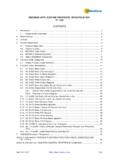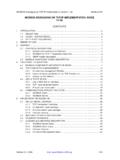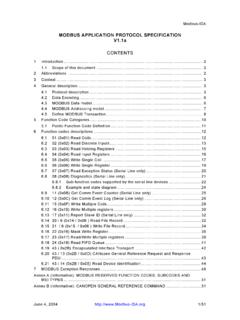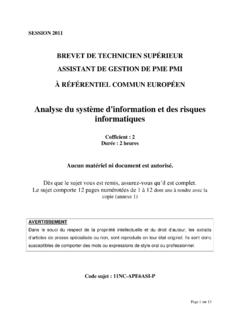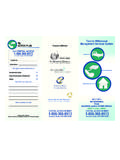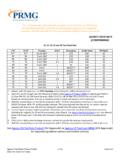Transcription of MODBUS APPLICATION PROTOCOL SPECIFICATION V1
1 MODBUS -IDA December 28, 2006 1/51 MODBUS APPLICATION PROTOCOL SPECIFICATION CONTENTS 1 Introduction ..2 Scope of this document ..2 2 Abbreviations ..2 3 Context .. 3 4 General description ..3 PROTOCOL description ..3 Data Encoding ..6 MODBUS Data model ..6 MODBUS Addressing model ..7 Define MODBUS 5 Function Code Categories ..10 Public Function Code Definition ..11 6 Function codes descriptions ..12 01 (0x01) Read Coils ..12 02 (0x02) Read Discrete 03 (0x03) Read Holding Registers ..15 04 (0x04) Read Input Registers ..16 05 (0x05) Write Single Coil ..17 06 (0x06) Write Single Register.
2 19 07 (0x07) Read Exception Status (Serial Line only) ..20 08 (0x08) Diagnostics (Serial Line only) ..21 Sub-function codes supported by the serial line devices ..22 Example and state diagram ..24 11 (0x0B) Get Comm Event Counter (Serial Line only) ..25 12 (0x0C) Get Comm Event Log (Serial Line only) ..26 15 (0x0F) Write Multiple Coils ..29 16 (0x10) Write Multiple registers ..30 17 (0x11) Report Slave ID (Serial Line only) ..32 20 (0x14) Read File Record ..32 21 (0x15) Write File Record ..34 22 (0x16) Mask Write 23 (0x17) Read/Write Multiple registers ..38 24 (0x18) Read FIFO 43 ( 0x2B) Encapsulated Interface Transport ..42 43 / 13 (0x2B / 0x0D) CANopen General Reference Request and Response PDU ..43 43 / 14 (0x2B / 0x0E) Read Device Identification ..44 7 MODBUS Exception Responses ..48 Annex A (Informative): MODBUS RESERVED FUNCTION CODES, SUBCODES AND MEI TYPES ..51 Annex B (Informative): CANOPEN GENERAL REFERENCE COMMAND.
3 51 MODBUS APPLICATION PROTOCOL SPECIFICATION MODBUS -IDA December 28, 2006 2/51 1 Introduction Scope of this document MODBUS is an APPLICATION layer messaging PROTOCOL , positioned at level 7 of the OSI model, that provides client/server communication between devices connected on different types of buses or networks. The industry s serial de facto standard since 1979, MODBUS continues to enable millions of automation devices to communicate. Today, support for the simple and elegant structure of MODBUS continues to grow. The Internet community can access MODBUS at a reserved system port 502 on the TCP/IP stack. MODBUS is a request/reply PROTOCOL and offers services specified by function codes. MODBUS function codes are elements of MODBUS request/reply PDUs. The objective of this document is to describe the function codes used within the framework of MODBUS transactions.
4 MODBUS is an APPLICATION layer messaging PROTOCOL for client/server communication between devices connected on different types of buses or networks. It is currently implemented using: y TCP/IP over Ethernet. See MODBUS Messaging Implementation Guide y Asynchronous serial transmission over a variety of media (wire : EIA/TIA-232-E, EIA-422, EIA/TIA-485-A; fiber, radio, etc.) y MODBUS PLUS, a high speed token passing network. TCPM odbus on TCPMODBUS APPLICATION LAYERIPE thernetPhysical layerEthernet II orEIA/TIA-485 Master / SlavePhysical layerMODBUS+ / HDLCO therOther Figure 1: MODBUS communication stack References 1. RFC 791, Internet PROTOCOL , Sep81 DARPA 2 Abbreviations ADU APPLICATION Data Unit HDLC High level Data Link Control HMI Human Machine Interface IETF Internet Engineering Task Force I/O Input/Output MODBUS APPLICATION PROTOCOL SPECIFICATION MODBUS -IDA December 28, 2006 3/51 IP Internet PROTOCOL MAC Medium Access Control MB MODBUS PROTOCOL MBAP MODBUS APPLICATION PROTOCOL PDU PROTOCOL Data Unit PLC Programmable Logic Controller TCP Transport Control PROTOCOL 3 Context The MODBUS PROTOCOL allows an easy communication within all types of network architectures.
5 PLCPLCHM II/ OI/ OI/ ODriveMODBUS ON TCP/IPGatewayGatewayGatewayMODBUS ON MB+ MODBUS ON RS232 MODBUS ON RS485De vic eHM IPLCPLCD riveI/ OI/ OI/ OI/ ODe vic eMODBUS COMMUNICATION Figure 2: Example of MODBUS Network Architecture Every type of devices (PLC, HMI, Control Panel, Driver, Motion control, I/O ) can use MODBUS PROTOCOL to initiate a remote operation. The same communication can be done as well on serial line as on an Ethernet TCP/IP networks. Gateways allow a communication between several types of buses or network using the MODBUS PROTOCOL . 4 General description PROTOCOL description The MODBUS PROTOCOL defines a simple PROTOCOL data unit (PDU) independent of the underlying communication layers. The mapping of MODBUS PROTOCOL on specific buses or network can introduce some additional fields on the APPLICATION data unit (ADU). MODBUS APPLICATION PROTOCOL SPECIFICATION MODBUS -IDA December 28, 2006 4/51 Additional addressFunction codeDataError checkADUPDUF igure 3: General MODBUS frame The MODBUS APPLICATION data unit is built by the client that initiates a MODBUS transaction.
6 The function indicates to the server what kind of action to perform. The MODBUS APPLICATION PROTOCOL establishes the format of a request initiated by a client. The function code field of a MODBUS data unit is coded in one byte. Valid codes are in the range of 1 .. 255 decimal (the range 128 255 is reserved and used for exception responses). When a message is sent from a Client to a Server device the function code field tells the server what kind of action to perform. Function code "0" is not valid. Sub-function codes are added to some function codes to define multiple actions. The data field of messages sent from a client to server devices contains additional information that the server uses to take the action defined by the function code. This can include items like discrete and register addresses, the quantity of items to be handled, and the count of actual data bytes in the field.
7 The data field may be nonexistent (of zero length) in certain kinds of requests, in this case the server does not require any additional information. The function code alone specifies the action. If no error occurs related to the MODBUS function requested in a properly received MODBUS ADU the data field of a response from a server to a client contains the data requested. If an error related to the MODBUS function requested occurs, the field contains an exception code that the server APPLICATION can use to determine the next action to be taken. For example a client can read the ON / OFF states of a group of discrete outputs or inputs or it can read/write the data contents of a group of registers. When the server responds to the client, it uses the function code field to indicate either a normal (error-free) response or that some kind of error occurred (called an exception response). For a normal response, the server simply echoes to the request the original function code.
8 Function codeData RequestClientServerInitiate requestPerform the actionInitiate the responseReceive the responseFunction codeData Response Figure 4: MODBUS transaction (error free) For an exception response, the server returns a code that is equivalent to the original function code from the request PDU with its most significant bit set to logic 1. MODBUS APPLICATION PROTOCOL SPECIFICATION MODBUS -IDA December 28, 2006 5/51 ClientServerInitiate requestError detected in the actionInitiate an errorException Function code Receive the responseException codeFunction codeData Request Figure 5: MODBUS transaction (exception response) ) Note: It is desirable to manage a time out in order not to indefinitely wait for an answer which will perhaps never arrive. The size of the MODBUS PDU is limited by the size constraint inherited from the first MODBUS implementation on Serial Line network (max.
9 RS485 ADU = 256 bytes). Therefore: MODBUS PDU for serial line communication = 256 - Server address (1 byte) - CRC (2 bytes) = 253 bytes. Consequently: RS232 / RS485 ADU = 253 bytes + Server address (1 byte) + CRC (2 bytes) = 256 bytes. TCP MODBUS ADU = 253 bytes + MBAP (7 bytes) = 260 bytes. The MODBUS PROTOCOL defines three PDUs. They are : MODBUS Request PDU, mb_req_pdu MODBUS Response PDU, mb_rsp_pdu MODBUS Exception Response PDU, mb_excep_rsp_pdu The mb_req_pdu is defined as: mb_req_pdu = {function_code, request_data}, where function_code = [1 byte] MODBUS function code, request_data = [n bytes] This field is function code dependent and usually contains information such as variable references, variable counts, data offsets, sub-function codes etc. The mb_rsp_pdu is defined as: mb_rsp_pdu = {function_code, response_data}, where function_code = [1 byte] MODBUS function code response_data = [n bytes] This field is function code dependent and usually contains information such as variable references, variable counts, data offsets, sub-function codes, etc.
10 MODBUS APPLICATION PROTOCOL SPECIFICATION MODBUS -IDA December 28, 2006 6/51 The mb_excep_rsp_pdu is defined as: mb_excep_rsp_pdu = {exception-function_code, request_data}, where exception-function_code = [1 byte] MODBUS function code + 0x80 exception_code = [1 byte] MODBUS Exception Code Defined in table " MODBUS Exception Codes" (see section 7 ). Data Encoding MODBUS uses a big-Endian representation for addresses and data items. This means that when a numerical quantity larger than a single byte is transmitted, the most significant byte is sent first. So for example Register size value 16 - bits 0x1234 the first byte sent is 0x12 then 0x34 ) Note: For more details, see [1] . MODBUS Data model MODBUS bases its data model on a series of tables that have distinguishing characteristics.

